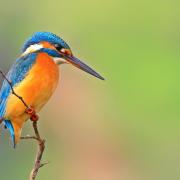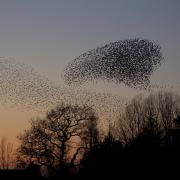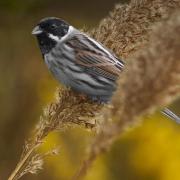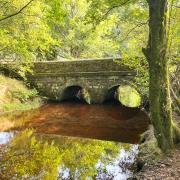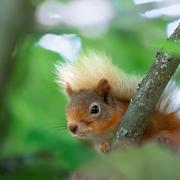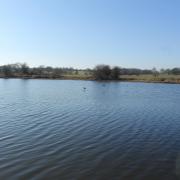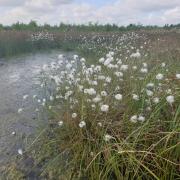After years of damaging peat extraction Lancashire’s mosslands are being restored. The Wildlife Trust campaigns manager Alan Wright visits two – Cadishead Moss and Little Woolden Moss in Salford

The first thing you notice about Little Woolden Moss is the sheer enormity of the place. When you stand on the footpath between Little Woolden and neighbouring Cadishead all you can see is the dark expanse of peat that seems to go on forever.
In the distance, you can see Winter Hill and Rivington but the vista is flat in between so the 114 hectares is all that your eye can take in. Then, there is the sky. The mosses between Salford, Liverpool, Wigan and Warrington, are known locally as Big Sky Country. On a day of sunshine and fluffy clouds, the black peat makes the whole place look even more spectacular.
Wildlife Trust staff and volunteers work here in all weathers. When the winds pick up speed they can bring rain and snow, just when you thought it was going to be sunny all day. Along with local birders – and birds – they are exposed to all kinds of weather.
Yet their toils are proving a great success and Little Woolden is starting to look greener and greener after more than 100 years of peat extraction. And the great thing is that you can see just how much it will improve by looking at the neighbouring Cadishead, which has been restored for nearly a decade now.

In early spring Defra announced it was allocating £10 million between four peat restoration projects in England, including £334,000 for work at Little Woolden Moss over the next three years. This means the restoration work will continue and be part of projects stretching from the Peak District to the Scottish border.
On Little Woolden Moss, the Lancashire Wildlife Trust will be carrying out restoration work that will help it on its way back to being a functioning lowland raised bog, part of the wider former Chat Moss complex and part of the Great Manchester Wetlands, which stretches to Warrington and Wigan.
Reserves Officer Martyn Walker said: ‘This is fantastic news for the national conservation of our peatland habitat and we are thrilled that Little Woolden Moss, one of our largest areas of peatland habitat, will benefit.
‘The funding will enable the Wildlife Trust to continue with our restoration works that have already brought about an amazing transformation of this former peat extraction site. Re-wetting works have already brought the water levels up over a large part of this peatland and the new funding will allow us not only to continue these works but to expand the restoration to the whole of the site.

‘As well as the re-wetting works, we can now plant a whole range of bog species such as hare’s-tail cotton-grass, heathers and bog mosses that will help to heal the and restore the bog to its former glory.’
In early summer cotton-grass spread over the reserve, almost looking like a snow scene, and this is good news for insects that feed on that plant and the birds that feed on the insects.
Little Woolden and Cadishead are already attracting many birds with local birder Dave Steel regularly recording more than 80 different species a month.
Oystercatchers, lapwings, little ringed plovers and other assorted waders love the moss. Curlews nested here in recent years and we have had rarities like the stone curlew, which is only, usually, seen in East Anglia.

Dave’s most recent list includes birds of prey like the peregrine, the hobby and the usual kestrels and buzzards.
A VIP visit was treated to a display by a young peregrine which was involved in a fracas with a gull. All the guests saw just how agile the falcons are.
He also mentions pied wagtails, yellow wagtails and white wagtails – I have never seen the latter so I will be keeping a close eye on my next visit.
Brown hare and roe deer often cross the mosses looking for food and shelter and adders and lizards have been spotted on the site.
National arachnids expert Rich Burkmar was amazed at his recent survey of Cadishead and Little Woolden. He found money spiders, sac spiders, orb web spiders, jumping spiders, wolf spiders and, frighteningly, a pseudoscorpion.
The best find was the tiny comb-footed spider, which has never been recorded in South Lancashire before. On Little Woolden, which has a lot fewer plants he found 18 species of spider.
While much of the moss will be too damp to walk on, new paths around the reserve and signage are making this area inviting for hikers and school children.
In an area of urban sprawl and agricultural businesses, Cadishead and Little Woolden offer a wilderness on the doorsteps of millions of people.
The moss footpath can be accessed along Moss Road in Cadishead. There is a car park half a mile from the site halfway along Moss Road.












